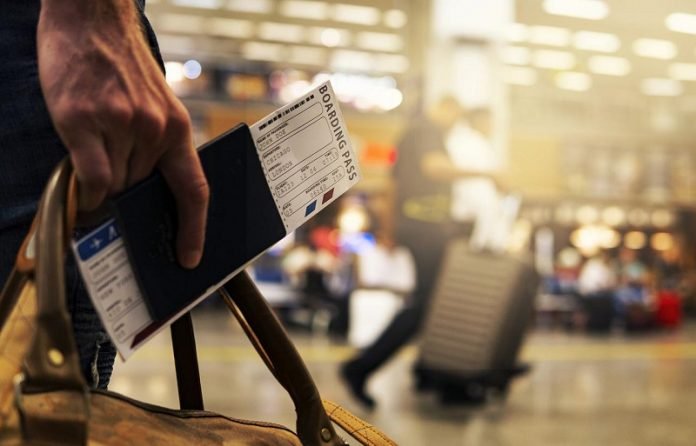
Don’t expect the flight cancellations and delays that plagued the July Fourth weekend to end any time soon.
Ravi Sarathy, professor of international business and strategy at Northeastern University, says cancellations, delays and the escalating cost of flights will probably get worse before they get better.
Labor shortages and bad weather will continue to create turbulence in the industry, he says.
There were more than 2,000 domestic flight cancellations over the July Fourth weekend.
On July 5, nearly 600 more were canceled and about 5,500 were delayed, according to FlightAware, a company that tracks the airline industry.
The disruptions continued through the rest of the week, with about 300 cancellations and 5,000 delays each day.
So far this year, the cancellation rate has been about 3%, says Kathleen Bangs, a spokesperson for FlightAware.
By comparison, she says, the cancellation rate in 2019 was less than 2%, but went up to 12% in 2020 during the pandemic.
The high volume of summer flights has put a huge burden on the airlines, which reduced staff, planes and flights during the COVID-19 pandemic.
Like many industries, airlines are also facing inflationary issues, including fuel costs that have more than doubled over the last year.
“Many airline personnel—from baggage handlers to pilots—took buyouts, furloughs and layoffs during the pandemic, as airlines’ load factors hit 20% to 30%, and half-empty planes were losing money,” Sarathy says.
Airline industry employment is on the rebound since the pandemic, but numbers still lag behind pre-pandemic totals.
In February of 2020, passenger airline employment was at a peak of 458,200 jobs, according to Airlines for America, an airline trade association and lobbying group.
The pandemic low point was in November of 2020 at 364,500 jobs. In April of this year, the total climbed to 445,600, still short of pre-pandemic numbers.
Bangs says the staffing shortage is the reason for the recent delays and cancellations. She says the onboarding process for new employees is slow because of background checks and training.
“The demand for travel came surging back but it’s like turning around a battleship,” she says.
Pilots who took a buyout or early retirement during the pandemic would have to start at the bottom of the seniority list if they wanted to come back, Bangs says, so that can be a deterrent to returning to the job.
“I think they’ve had a harder time attracting people than they thought they would,” Bangs says.
The airlines also took a lot of planes out of service during the pandemic as they cut back on routes with such low demand.
Now, Sarathy says, they are struggling to restock their fleets. It takes two to three years to get delivery of a new passenger plane, and with only two aircraft makers—Boeing and Airbus—the airlines cannot meet the current demand.
Bringing back planes taken out of commission is not always cost effective, he says.
In December of 2019, before the pandemic, there were 5,780 passenger planes in service, according to Airlines for America.
In December 2020, the industry had 4,671 planes. The industry started increasing planes and service in 2021, finishing the year with 5,427 planes. At the end of June this year, there were 5,570 planes in service.
Another factor contributing to this perfect storm in the industry is the weather. The volatile summer weather has caused a spike in delays and cancellations, Sarathy says, and those regional weather issues have a cascading effect across the country.
“I think it should get better in the fall,” Sarathy says, because the summer vacation demand will subside and a possible recession could diminish consumer spending on airfare.
“As we ease into fall, and schools reopen, people go back to work after vacations, the traffic surge should slow, allowing for better route planning and fewer cancellations,” Sarathy says.
The price of airfare is already down for flights in the fall, Bangs points out.
But the weather itself is not the problem, Bangs says. There has not been a greater number of weather events this year, but when there is a delay because of weather, the airlines don’t have the staff to adjust and reschedule.
“They just don’t have the manpower to meet those weather events,” she says.
The high demand has caused a surge in the cost of airfare. The industry suffered significant losses for a couple of years during the COVID-19 pandemic, Sarathy says, and now the airlines are trying to recover.
“Because demand is up, prices go up,” Bangs says. “Part of that is the cost of fuel; that will always be the case.”
The airlines, like so many industries, are greatly affected by the rising cost of fuel. Jet fuel prices averaged $4.21 in June this year, up 122% from $1.90 in June 2021, according to Airlines for America.
“As airlines add more planes and more flights, I think the prices will come down,” Sarathy says.
U.S. airlines are projected to post modest profits in 2022, according to Airlines for America, and companies will use those profits to retire the massive debt accumulated in 2020–2021 to weather the pandemic. The organization says airline industry debt—and interest expense—will remain elevated through at least 2024.
The pre-pandemic pre-tax profit margin for airlines was 9.6% in 2017 to 2019; however, in 2021 the industry was running in the red at -2.6%.
Written by Mark Conti.



